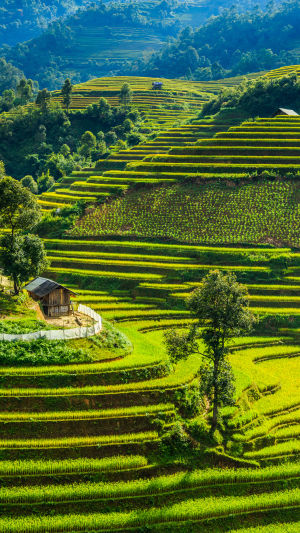When it comes to terraced fields, people will think of the stair-like terraced fields on the mountains. In fact, the concept of terraced fields is very broad.
Terrace is explained in "Encyclopedia - Agriculture" as "a terraced or wavy cross-section farmland built along the contour line on a sloping land". The so-called terraced field is a step-type terrace built on a slope along the contour line, and can be divided into:
There are four types of horizontal terraces, slope terraces, reverse-slope terraces and split-slope terraces, which are mostly found in Japan, Southeast Asia and other countries with fewer people and more place.
Wave terraces are farmland with wave-shaped cross-sections built on gentle slopes, which are convenient for mechanical farming. They are mainly distributed in sparsely populated countries such as the United States, Australia.
Terraced fields first appeared in prehistoric times. At first people cleared forests or hilltops in order to grow some food crops, or as fortifications. Around the same time, such terraces began to appear around the world.
Terraced fields are fields with strip-shaped terraces or wavy sections built along the contour line on the hillsides. One of the effective measures to prevent soil erosion on sloping farmland is to build terraced fields, which have obvious effects on increasing yield, storing water, and protecting soil.
It has excellent ventilation and light transmission conditions, which is favorable for crop growth and nutrient accumulation.
According to the slope of the fields, terraces can generally be divided into sloping terraces, duplex terraces and horizontal terraces.
The width of the terraces is determined according to the slope of the ground, the farming method and the thickness of the soil layer, as well as economic conditions, and is planned in a unified manner with the irrigation and drainage system and traffic roads.
The topsoil should be retained when constructing terraces. After the terraces are completed, agricultural cultivation measures such as deep ploughing, increasing application of organic fertilizers, and suitable planting of pioneer crops should be adopted to accelerate soil maturity and improve soil fertility.
According to local conditions, some places also need to store water for irrigation. In fact, the mountains where terraces can be built are those with lush paper cups. The ecological circle formed by some natural environments on the mountains is already very good. Naturally, it can store a lot of water, and it can be self-sufficient in years with sufficient rain.
And generally after the construction of terraced fields, people will also build reservoirs according to the location of these terraced fields and some natural conditions of the mountain.
The mountain itself will also have springs. The ponds are dug near the springs, which can not only store rainwater but also use the springs. In the case of less precipitation in the later period, water sources from ponds and springs can be used for irrigation.





